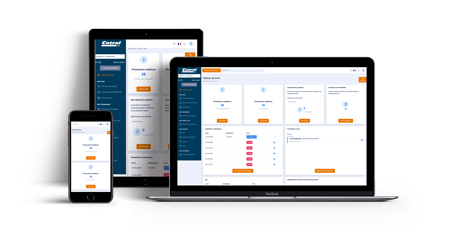Quality of life at work (QWL) has become a major strategic focus for companies. This trend is related to the fact that absenteeism, burn-out, etc. has increased but also because employees are less and less engaged and identify less with their company than before. To remedy this problem, all companies, whatever their size, put in place means to promote the well-being of their employees and the employer branding process.

What is well-being at work?
According to the definition of the World Health Organization (WHO), well-being at work is "a state of mind characterized by a satisfactory harmony between the skills, needs and aspirations of the worker and the other the constraints and opportunities of the workplace".
It is therefore an individual feeling, therefore the concept of well-being at work is very subjective because it depends on the perception and feeling of each individual. Well-being at work aims to protect the physical, moral and social health of employees of a company so that they flourish.
It encompasses factors relating to working conditions such as:
- Safety: signalling danger areas, fire prevention and electrical hazards ...
- Protection of employees health: heating. Protection from noise, from tabacco,provision of first aid equipment...
- Ergonomics: The layout of work stations in order to reduce muscular-skeletal problems...
- Psycho-social issues: reduce stress, tiredness, deal with bullying at work...
- Hygiene: toilets, general cleanliness and sanitation...
Well-being at work: what are the issues?
If well-being is increasingly taken into account by employers it is because there are several issues at stake:
- Happiness at work: the goal is for employees to feel good, to feel content, as if they were at home.
- Improved productivity: Many studies have demonstrated that well-being at work produces better productivity. In effect, it reduces levels of absenteeism and increases motivation. Staff become more creative and more efficient.
- Reduction of psycho-social risks: Employees are less stressed, more relaxed and this increases productivity.
- Competitiveness in the labour market: The labour market is extremely competitive. In fact, employees are no longer afraid to change their business if they are not satisfied. Employee turnover increases which is not desirable for the stability of the company. Working conditions help to retain employees and attract the best candidates. This is particularly the goal of those companies where it is good to work as Great Place To Work or Top Employer.
- Economic issues: A study by Mozart Consulting shows that the cost of feeling bad at work and absenteeism is extremely high, in the region of €12,600 per employee.

These issues are fundamental to the smooth-running of a company, because beyond economic performance, they allow a social performance where employees are more committed, cooperate and give meaning to their work.
How do companies respond to these issues
A variety of means are engaged by companies to influence the quality of life at work in a positive manner.
Protect the health and ensure the safety of employees
For those companies whose employees are exposed to high risks, ensuring their well being consists of protecting them and assuring their safety. This means providing personal protection equipment according to the dangers faced ( safety shoes, custom made hearing protection, hearmuffs, gloves etc).
Grant more freedom to its employees
Some companies now leave it to their employees to choose where they work and to structure their own work time. The introduction of the right to work from a distance allows employees to work from home or engage in job sharing, for example. Office hours also become more flexible when activities permit.
Thus, the image of the company is enhanced, appearing to be conciliatory.
Restructuring offices
The practice of telecommuting has led many companies to rethink their workspaces:
- More communal spaces
- Offices no longer belong to just one person (hot desking)
- Everyone is free to undertake his role wherever he wishes, in a rest room, in a cafeteria etc, it's often nicknamed "nomadism"
There is greater use of space. Companies invest in relaxation areas (cafeteria, gym, rest room, etc.), brainstorming spaces that allow employees to be quiet and focus, etc. Decoration is not left to chance and may be different depending on the type of room.
Recruiting a CHO
A CHO ( Chief Happiness Officer) is a manager of a completely different kind, first appearing in the United States, and now appearing in France. Their role is, literally, to ensure the happiness of each worker and to ensure their well-being.
To fulfil his role, a CHO must pay attention to each employee and offer solutions. He provides internal communication, organizes events, offers sports workshops, wellness activities (massage, yoga).

These activities fosters self development but also helps relieve pressure and cultivate a team spirit that creates a friendly atmosphere in the company.
Noise as a factor in QWL
Noise is an important element in quality of work life and has a negative impact. Indeed, an Ifop survey shows that the majority of employees are bothered by noise and that noise pollution is not without impact.
Such nuisance can be caused by colleagues phone conversations, footsteps, keyboards, doors, machinery and external noise etc
Effects of noise
In offices, noise generally never exceeds 50dB yet it is the primary cause of disruption at work. One in two workers say that they are adversely affected by noise in their workplace to an extent that it affects their effectiveness.
The consequences of noise are not minimal:
- Loss of time: Noise can cause up to 30 mins lost work a day.
- Loss of concentration: Employees are more likely to make errors. In fact, according to one study by David Rock (Your Brain in the Office), employees are likely to be put out by noise every 11 minutes. By way of comparison, it is estimated that the brain requires 23 minutes to settle back into concentration.
- Loss of productivity: Someone who loses time and concentration is less productive.
- Effects on health: we see an increase in tiredness giving rise to stress.
It's vital for companies to find solutions to deal with noise for the sake of their employees.
In industry, because noise is louder, it has far more serious consequences and can result in:
- Sleep disturbance
- Cardiovascular problems
- Vertigo
- Tinnitus
- Hearing loss
The solutions for combatting noise at work
There are two types of solutions to reduce noise:
- Global solutions: reducing the source of the noise, constructing acoustic partitions to assist in phonic insulation, these solutions help reduce overall noise in the general area. They are effective but costly and can be complicated to put in place.
- Individual solutions: Headphones or audio earbuds, disposable foam ear plugs, custom made protectors. These solutions are equally effective, less costly and allows you to equip just those who require it.
Protect your employees from noise to increase their productivity
Noise is everywhere and is considered as a nuisance that impedes your workers from performing to their full potential. It is important to act to improve their comfort and their ability to work. To help you learn more about noise and learn how to combat it download your Guide "6 essential elements against noise at work".

